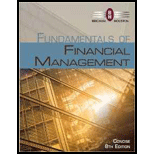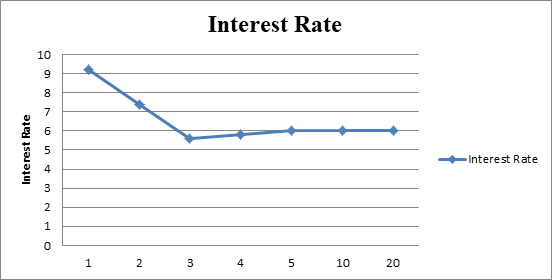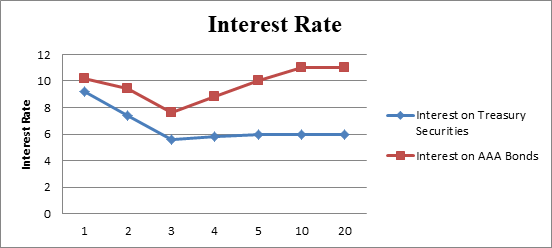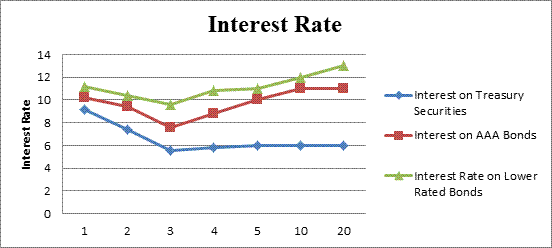
Concept explainers
a.
To identify: The interest on Treasury securities, and yield curve.
Yield:
Yield is the percentage of securities at which the return is provided by the company to its investors. Yield can be there in the form of dividend and interest.
Yield Curve:
The graphical representation of the expected return, provided by the company to its investors during the years is known as the yield curve.
a.
Answer to Problem 18P
The items required for the calculation of interest rate are the real risk-free rate, inflation rate, and maturity risk premium.
Explanation of Solution
Given,
The risk free rate is 2% or 0.02.
Inflation rate for the first year is 7% or 0.07.
The inflation rate of second year is 5% or 0.05.
The inflation rate after two years is 3% or 0.03.
The maturity risk premium for the first year is 0.2% or 0.002 and it will increase by 0.2% every year till 1%.
Formula to calculate the interest rate,
Where,
- r is the corporate bond yield.
- r* is the risk free rate.
- IP is the inflation premium.
- MRP is the maturity risk premium.
Statement to show the calculation of interest rate
| Maturity |
Real Risk-Free Rate (%) (r*) |
Inflation Rate (%) (IP) |
Maturity Risk Premium (MRP) |
Interest Rate on Treasury Bond
|
| 1 | 2 | 7 | 0.2 | 9.20 |
| 2 | 2 | 5 | 0.4 | 7.40 |
| 3 | 2 | 3 | 0.6 | 5.60 |
| 4 | 2 | 3 | 0.8 | 5.80 |
| 5 | 2 | 3 | 1 | 6 |
| 10 | 2 | 3 | 1 | 6 |
| 20 | 2 | 3 | 1 | 6 |
Table (1)
The yield curve of the given data

Fig 1
- The x-axis represents the maturity.
- The y-axis represents the interest rate.
- The interest rates with their respective time period can be shown from the graph.
Hence, the interest of 1-year treasury securities is 9.20%, at 2-year treasury securities is 7.60%, 3-year treasury securities is 5.60%, 4-year treasury securities is 5.80% and thereafter is 6%.
b.
To identify: The interest rate on AAA rated securities, and the yield curve.
b.
Answer to Problem 18P
The items required for the calculation of interest rate are real risk-free rate, inflation rate, and maturity risk premium.
Explanation of Solution
Explanation:
Given,
The risk free rate is 2% or 0.02.
Inflation rate for the first year is 7% or 0.07.
The inflation rate of second year is 5% or 0.05.
The inflation rate after two years is 3% or 0.03.
The maturity risk premium for the first year is 0.2% or 0.002 and it will increase by 0.2% every year till 1%.
The default risk premium is 1% which increases
Formula to calculate the interest rate,
Where,
- r is the corporate bond yield.
- r* is the risk free rate.
- IP is the inflation premium.
- MRP is the maturity risk premium.
- DRP is the default risk premium.
Statement to show the calculation of interest rate
| Maturity |
Real Risk-Free Rate (%) (r*) |
Inflation Rate on Treasury Bond (%) (IP) |
Maturity Risk Premium (%) (MRP) |
Interest Rate on Treasury Bond
|
Default Risk Premium (%) (DRP) |
Interest Rate on AAA rated Bonds
|
| 1 | 2 | 7 | 0.2 | 9.20 | 1 | 10.20 |
| 2 | 2 | 5 | 0.4 | 7.40 | 2 | 9.40 |
| 3 | 2 | 3 | 0.6 | 5.60 | 2 | 7.60 |
| 4 | 2 | 3 | 0.8 | 5.80 | 3 | 8.80 |
| 5 | 2 | 3 | 1 | 6 | 4 | 10 |
| 10 | 2 | 3 | 1 | 6 | 5 | 11 |
| 20 | 2 | 3 | 1 | 6 | 5 | 11 |
Table (2)
The yield curve of the given data

Fig 2
- The x-axis represents the maturity.
- The y-axis represents the interest rate.
- The interest rates of treasury securities and AAA bonds with their respective time period can be shown from the graph.
Hence, the interest of 1-year AAA bond is 10.20%, at 2-year AAA bond is 9.40%, 3-year AAA bond is 7.60%, 4-year AAA bond is 8.80% 5-year AAA bond is 10% and thereafter it is 11%.
c.
To identify: The interest rate on lower rated bonds, and the yield curve.
c.
Answer to Problem 18P
The items required for the calculation of interest rate are the inflation rate, real risk-free rate, and maturity risk premium.
Explanation of Solution
Given,
The risk free rate is 2% or 0.02.
Inflation rate for the first year is 7% or 0.07.
The inflation rate of second year is 5% or 0.05.
The inflation rate after two years is 3% or 0.03.
The maturity risk premium for the first year is 0.2% or 0.002 and it will increase by 0.2% every year till 1%.
The default risk premium is 1% which increases
Formula to calculate the interest rate,
Where,
- r is the corporate bond yield.
- r* is the risk free rate.
- IP is the inflation premium.
- MRP is the maturity risk premium.
- DRP is the default risk premium.
Statement to show the calculation of interest rate on AAA rated bonds
| Maturity |
Real Risk-Free Rate (%) (r*) |
Inflation Rate on Treasury Bond (%) (IP) |
Maturity Risk Premium (%) (MRP) |
Default Risk Premium (%) (DRP) |
Interest Rate
|
| 1 | 2 | 7 | 0.2 | 1 | 10.20 |
| 2 | 2 | 5 | 0.4 | 2 | 9.40 |
| 3 | 2 | 3 | 0.6 | 2 | 7.60 |
| 4 | 2 | 3 | 0.8 | 3 | 8.80 |
| 5 | 2 | 3 | 1 | 4 | 10 |
| 10 | 2 | 3 | 1 | 5 | 11 |
| 20 | 2 | 3 | 1 | 5 | 11 |
Table (3)
Statement to show the calculation of interest rate on lower rated bonds
| Maturity |
Real Risk-Free Rate (%) (r*) |
Inflation Rate on Treasury Bond (%) (IP) |
Maturity Risk Premium (%) (MRP) |
Default Risk Premium on Lower rated Bonds (%) (DRP) |
Interest Rate (%)
|
| 1 | 2 | 7 | 0.2 | 2 | 11.2 |
| 2 | 2 | 5 | 0.4 | 3 | 10.40 |
| 3 | 2 | 3 | 0.6 | 4 | 9.60 |
| 4 | 2 | 3 | 0.8 | 5 | 10.80 |
| 5 | 2 | 3 | 1 | 5 | 11 |
| 10 | 2 | 3 | 1 | 6 | 12 |
| 20 | 2 | 3 | 1 | 7 | 13 |
Table (4)
The yield curve of the given data

Fig 2
- The x-axis represents the maturity.
- The y-axis represents the interest rate.
- The interest rates of Treasury securities, AAA bonds and lower rated bonds with their respective time period can be shown from the graph.
Hence, the interest of 1-year lower rated bond is 11.20%, at 2-year lower rated bond is 10.40%, 3-year lower rated bond is 9.60%, 4-year lower rated bond is 10.80% 5-year lower rated bond is 11%, 10-year lower rated bond is 12% and thereafter is 13%.
Want to see more full solutions like this?
Chapter 6 Solutions
Bundle: Fundamentals of Financial Management, Concise Edition (with Thomson ONE - Business School Edition 6-Month Printed Access Card), 8th + Aplia Printed Access Card
- John and Jane Doe, a married couple filing jointly, have provided you with their financial information for the year, including details of federal income tax withheld. They need assistance in preparing their tax return. W-2 Income: John earns $150,000 with $35,000 withheld for federal income tax. Jane earns $85,000 with $15,500 withheld for federal income tax. Interest Income: They received $2500 in interest from a savings account, with no tax withheld. Child Tax Credit: They have two children under the age of 17. Mortgage Interest: Paid $28,000 in mortgage interest on their primary residence. Property Taxes: Paid $4,800 in property taxes on their primary residence. Charitable Donations: Donated $22,000 to qualifying charitable organizations. Other Deductions: They have no other deductions to claim. You will gather the appropriate information and complete the forms provided in Blackboard (1040, Schedule A, and Schedule B in preparation of their tax file.arrow_forwardOn the issue date, you bought a 20-year maturity, 5.85% semi-annual coupon bond. The bond then sold at YTM of 6.25%. Now, 5 years later, the similar bond sells at YTM of 5.25%. If you hold the bond now, what is your realized rate of return for the 5-year holding period?arrow_forwardBond Valuation with Semiannual Payments Renfro Rentals has issued bonds that have an 11% coupon rate, payable semiannually. The bonds mature in 17 years, have a face value of $1,000, and a yield to maturity of 9.5%. What is the price of the bonds? Round your answer to the nearest cent.arrow_forward
- analyze at least three financial banking products from both the liability side (like time deposits, fixed income, stocks, structure products, etc). You will need to examine aspects such as liquidity, risk, and profitability from a company and an individual point of view.arrow_forwardHow a does researcher ensure that consulting recommendations are data-driven? What does make it effective, and sustainable? Please help explain and give the example How does DMAC help researchers to improve their business processes? How to establish feedback loops for ongoing refinement. Please give the examplesarrow_forwardDon't used hand raiting and don't used Ai solutionarrow_forward
- Explain what the business model of payday lenders, title pawn lenders, and “credit approved” used car dealers.arrow_forwardThe current NPV of a $30 million bond with 9% interest, 8% coupon rate, and discounted at $95arrow_forwardCould you please help to explain the DMAIC phases and how a researcher would use them to conduct a consulting project? What is a measure process performance and how to analyze the process? What is an improve process performance and how the control improves process and future process performance?arrow_forward
- Consider the two stocks below. Graph the frontier of combinations of the two stocks. Show the effect on the frontier of varying the correlation from −1 to +1. 1 2 3 Mean A B C D TWO STOCKS Varying the correlation coefficient Stock A Stock B 3.00% 8.00% 4 Sigma 15.00% 22.00% 5 Correlation 0.3000 Farrow_forwardLindsay is 30 years old and has a new job in web development. She wants to make sure that she is financially sound by the age of 55, so she plans to invest the same amount into a retirement account at the end of every year for the next 25 years. (a) Construct a data table in Excel that will show Lindsay the balance of her retirement account for various levels of annual investment and return. If Lindsay invests $10,000 at return of 6%, what would be the balance at the end of the 25th year? Note that because Lindsay invests at the end of the year, there is no interest earned on the contribution for the year in which she contributes. Round your answer to a whole dollar amount. $ (b) Develop a two-way table for annual investment amounts of $5,000 to $20,000 in increments of $1,000 and for returns of 0% to 12% in increments of 1%. From the 2-way table, what are the minimum annual investments Lindsay must contribute for annual rates ranging from 6% to 11%, if she wants to…arrow_forwardDoes Airbnb have any impaired assets? If so, what are they?arrow_forward
 EBK CONTEMPORARY FINANCIAL MANAGEMENTFinanceISBN:9781337514835Author:MOYERPublisher:CENGAGE LEARNING - CONSIGNMENT
EBK CONTEMPORARY FINANCIAL MANAGEMENTFinanceISBN:9781337514835Author:MOYERPublisher:CENGAGE LEARNING - CONSIGNMENT Intermediate Financial Management (MindTap Course...FinanceISBN:9781337395083Author:Eugene F. Brigham, Phillip R. DavesPublisher:Cengage Learning
Intermediate Financial Management (MindTap Course...FinanceISBN:9781337395083Author:Eugene F. Brigham, Phillip R. DavesPublisher:Cengage Learning

